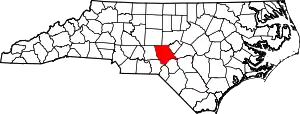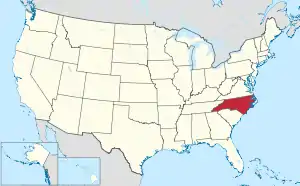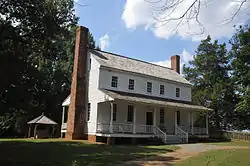Moore County, North Carolina
Moore County is a county located in the U.S. state of North Carolina. As of the 2020 census, its population was 99,727.[1] Its county seat is Carthage and its largest community Pinehurst. It is a border county between the Piedmont and the Atlantic Coastal Plain.
Moore County | |
|---|---|
 Moore County Courthouse in Carthage | |
 Flag  Seal | |
 Location within the U.S. state of North Carolina | |
 North Carolina's location within the U.S. | |
| Coordinates: 35°19′N 79°29′W | |
| Country | |
| State | |
| Founded | 1784 |
| Named for | Alfred Moore |
| Seat | Carthage |
| Largest community | Pinehurst |
| Area | |
| • Total | 705.69 sq mi (1,827.7 km2) |
| • Land | 697.68 sq mi (1,807.0 km2) |
| • Water | 8.00 sq mi (20.7 km2) 1.13% |
| Population (2020) | |
| • Total | 99,727 |
| • Estimate (2022) | 105,531 |
| • Density | 142.94/sq mi (55.19/km2) |
| Time zone | UTC−5 (Eastern) |
| • Summer (DST) | UTC−4 (EDT) |
| Congressional district | 9th |
| Website | www |
In the early years, the economy was dependent on agriculture and lumber. The lumber business expanded after railroads reached the area, improving access to markets. It lies at the northern edge of the area known as the Sandhills region, and developed resorts in the late 19th century, aided by railroads.
Since the early 21st century, Moore County comprises the Pinehurst-Southern Pines, NC Metropolitan Statistical Area. Moore County is a part of the Fayetteville-Lumberton-Pinehurst, NC Combined Statistical Area, which had a population of 834,094 in 2020, making it the 66th largest CSA in the United States.[2][3]
History
Archeological evidence indicates Siouan Native Americans inhabited the area eventually comprising Moore County from the early 500s until the 1600s. European settlers arrived in about 1739. In subsequent years, settlers of English, Ulster Scots, and German origin arrived by way of the Great Wagon Road and from the Cape Fear River valley, with most choosing to reside in the northern section of the eventual county. From the 1750s to the 1770s, the area received an influx of settlers from the Scottish Highlands, who mostly occupied the southeastern portions of the county and developed a naval stores industry with the area's longleaf pines.[4] The Scots also brought African slaves to the area.[5]

Settlement decreased during the American Revolutionary War. Settlers in the northern portion of the eventual county generally supported the Patriots, while the Highlands Scots in the southeastern area were mostly Loyalists.[4] In July 1781 a Patriot–Loyalist skirmish took place at the House in the Horseshoe.[6] Many Loyalists were socially ostracized after the end of the war.[4] Moore County was formed in 1784, from part of Cumberland County. It was named after Alfred Moore, an officer in the American Revolutionary War and a later associate justice of the Supreme Court of the United States.[7] A courthouse was erected the following year.[4] The county's boundaries were redrawn several times between 1784 and 1829.[8] The county's northern section benefited from economic development in the years after its creation. In 1796, a law was passed designating the county seat at a new community to be known as Carthage,[7] where the courthouse was eventually moved in 1814. A new one was built six years later. Another one was built in 1840.[4]

Many men from the county served in the American Civil War.[4] In 1877, the Raleigh and Augusta Air Line Railroad was established and laid through Moore, leading to the creation of new communities. Logging of the local pines increased and the rail towns of Cameron, Manly, Keyser, and Aberdeen were built to ship the lumber.[4][9] Most of the county's old-growth pine forests were depleted by 1900.[10] With large swathes of lands cleared and transportation links well-established, new health resort towns and mineral spas were created, such as Southern Pines, Pinehurst, Pinebluff, and Jackson Springs.[4][9]
In 1897, the first golf courses were established in the county. The number of courses expanded over the years and drew in wealthy vacationers from New England and the Mid-Atlantic, who built seasonal homes in Pinehurst and Southern Pines. Fox hunting and polo and equestrian activities also grew in popularity.[9] In 1907, parts of Moore and Chatham counties were combined to form Lee County.[11] In 1922, the present Moore County Courthouse was built.[4] In 1958, the Little River Township of Hoke County was annexed to Moore.[12]
Moore County has many golf resorts in the Southern Pines/Pinehurst area, and hosted the 1996 and 2001 Women's U.S. Opens, as well as the 1999 and 2005 Men's U.S. Opens. The Women's Open returned to Southern Pines in 2007. In 2014, they consecutively hosted both the Women's and Men's Opens in the same year, a first in U.S. Open history.[13]
Geography

According to the U.S. Census Bureau, the county has a total area of 705.69 square miles (1,827.7 km2), of which 697.68 square miles (1,807.0 km2) is land and 8.00 square miles (20.7 km2) (1.13%) is water.[14] Moore County is bordered by Chatham, Lee, Harnett, Cumberland, Hoke, Scotland, Richmond, Montgomery County, and Randolph counties.[4] It lies mostly within the Piedmont region, though some of the county extends into the state's Coastal Plain.[15] Additionally, the county lies within the Sandhills region,[16] and about two-thirds of its land are host to sandy soils.[17] The county drains into the Cape Fear River Basin and Lumber River Basin.[18] Local waterways include Pine Lake, Deep and Little Rivers[19][20] and Aberdeen, Big Governors, Big Juniper, Drowning, Herds, McLendons, Sugar, and Little Crane Creeks.[15][21][22][23]
Longleaf pine is native to the region.[24] It grows in the Sandhills Game Land, a state nature preserve which covers part of Moore County,[25] and the Weymouth Woods-Sandhills Nature Preserve, which resides wholly in the county.[26] Fish present in the county include bass, sunfish,[27] and Cape Fear shiner.[19] The endangered red-cockaded woodpecker resides in the area.[16]
Demographics
2020 census
As of the 2020 census, there were 99,727 people. Racially, 77 percent of county residents identified as white, 10 percent as black, 7.4 percent as Hispanic/Latino, 2.8 as Native American, and 1.3 percent as Asian.[28] Compared to the rest of the state, the population of the county is older and more white.[16] For the first time, the census classified the municipalities of Pinehurst, Southern Pines, Aberdeen, Pinebluff, Taylortown, and Whispering Pines as constituting a contiguous urban area, due to the combined population of those areas exceeding 50,000 people.[29]
Demographic change
| Historical population | ||||||||||||||||||||||||||||||||||||||||||||||||||||||||||||||||||||||||||||||||||||||||||||||||||||||||||||
| ||||||||||||||||||||||||||||||||||||||||||||||||||||||||||||||||||||||||||||||||||||||||||||||||||||||||||||
Between 2010 and 2020, Moore County grew by 11,480 residents.[28] The North Carolina Office of State Budget and Management projected in 2023 that the county's population will grow to be 146,972 in 2040 and 170,097 in 2050.[29]
Law and government
Government
Carthage is the seat of Moore County.[15] The county's government is led by a five-member board of commissioners. The commissioners are elected at-large but represent districts in which they reside. The board is responsible for levying taxes and appropriating county funds, issuing ordinances within the confines of state law, and overseeing county government administration.[35] The commissioners appoint a county manager who leads the everyday function of county administration under the commissioners' direction. They also appoint their own clerk, a county attorney, and a tax administrator. In addition to the commissioners, county voters elect a register of deeds.[4]
Moore County is a member of the Triangle J Council of Governments, a regional planning body.[36] It is located in North Carolina's 9th congressional district,[37] the North Carolina Senate's 21st district, and the North Carolina House of Representatives' 51st, 52nd, and 78th districts.[38]
Judicial system

Moore County lies within the bounds of North Carolina's 29th Prosecutorial District, the 19D Superior Court District, and the 19D District Court District.[39] County voters elect a sheriff.[4]
Politics
| Historical presidential election returns | |||||||||||||||||||||||||||||||||||||||||||||||||||||||||||||||||||||||||||||||||||||||||||||||||||||||||||||||||||||||||||||||||||||||||||||||||||||||||||||||||||||||||||||||||||||||||||||||||||||||||||||||||||||||||||||||||||||||||||||||||||||||||||||||||||||||||
| |||||||||||||||||||||||||||||||||||||||||||||||||||||||||||||||||||||||||||||||||||||||||||||||||||||||||||||||||||||||||||||||||||||||||||||||||||||||||||||||||||||||||||||||||||||||||||||||||||||||||||||||||||||||||||||||||||||||||||||||||||||||||||||||||||||||||
Politically, Moore County is dominated by the Republican Party. As of December 2022, the county hosts 15,812 registered Democrats, 31,387 Republicans, four members of the Green Party, 613 Libertarians, and 28,112 unaffiliated voters.[41]
Economy
Moore County residents are on average wealthier than their statewide contemporaries.[16] In mid-2021, the United States Census Bureau reported the county's median annual income as $63,324.[41] As of December 2022, the poverty rate was about nine percent.[16] Healthcare and social assistance, accommodation and food services, and retail are the largest-employing private sectors in Moore.[42] Moore's economy also relies heavily on tourism, largely driven by golfing events. In 2021, the county benefitted from $673 million in tourism spending, giving it the 10th largest tourism economy among North Carolina's counties.[43] Some county residents work in both civilian and military capacities at the U.S. Army's Fort Liberty in neighboring Cumberland County. Some manufacturing also takes place in Moore.[16]
Transportation
Public airplane facilities are provided by the Moore County Airport, located near Pinehurst and Southern Pines,[44] though many air travelers opt to fly into Raleigh-Durham International Airport before driving to Moore.[45] A private airport, Gilliam–McConnell Airfield is maintained in Carthage.[46] North–south rail lines are operated by CSX Transportation, with additional short-line rail service provided by the Aberdeen, Carolina and Western Railway and the Aberdeen & Rockfish Railroad Company.[44] Amtrak maintains a passenger rail station in Southern Pines.[47][48]
Education
Public primary and secondary education in the county is provided by Moore County Schools. Of the county's K-12 students, 72 percent are enrolled in public schools, 16 percent are enrolled in private and charter schools, and 11 percent are homeschooled. Post-secondary education is provided by the Sandhills Community College, which has its main campus in Moore.[50] SandHoke Early College, a program managed by Hoke County Schools, also uses the campus.[51] According to the 2021 American Community Survey, an estimated 40.8 percent of county residents have attained a bachelor's degree or higher level of education.[52]
Culture
Many Moore County residents helped developed the regional pottery craft centered in Jugtown, Randolph County. The county is host to the Moore County Agricultural Fair, the Carthage Buggy Festival, the Pet Parade and Bark-in-the-Park Festival, and the North Carolina Playwright Festival.[15] The Moore County Hounds hunting club hosts an annual British-style traditional fox hunt, the Blessing of the Hounds, on Thanksgiving Day.[53][54] Moore County, particularly the Pinehurst–Southern Pines area, host many golf courses and golfing tournaments.[16][55] Equestrianism is popular in the county.[16] Several area buildings and sites have been listed on the National Register of Historic Places.[15][56]
Communities

Incorporated communities
Townships
The county is divided into ten townships, which have no legal or political authority:[4]
- Carthage
- Bensalem
- Sheffields
- Ritter
- Deep River
- Greenwood
- McNeill
- Sandhill
- Mineral Springs
- Little River
Census-designated place
Unincorporated communities
Notable people
- Charles Brady (1951-2006), was raised here. He became a physician, career Navy officer, and NASA astronaut
- John Edwards (born 1953), politician, US Senator and former presidential candidate was raised here
- Jeff Hardy (born 1977) and Matt Hardy (born 1974), brothers, were raised here; they are professional wrestlers currently working in All Elite Wrestling as The Hardy Boyz
- Shannon Moore (born 1979), was raised here; he is a wrestler currently working in the Independent Circuit
- Shanann Watts (1984-2018), murdered with her two daughters by her husband Chris in Colorado in 2018[67]
See also
- List of counties in North Carolina
- Moore County substation attack, electrical substation attack in 2022
References
- "U.S. Census Bureau QuickFacts: Moore County, North Carolina". United States Census Bureau. Retrieved May 31, 2022.
- "OMB Bulletin No. 23-01: Revised Delineations of Metropolitan Statistical Areas, Micropolitan Statistical Areas, and Combined Statistical Areas, and Guidance on Uses of the Delineations of These Areas" (PDF). United States Office of Management and Budget. July 21, 2023. Retrieved August 10, 2023.
- "Metropolitan and Micropolitan Statistical Areas Population Totals and Components of Change: 2020-2021". United States Census Bureau. February 24, 2022. Retrieved August 10, 2023.
- "Moore Community : Our History". County of Moore, North Carolina. County of Moore Government. Retrieved April 18, 2023.
- Southern Pines Comprehensive Long Range Plan 2016, pp. B-24, B-25.
- "House in the Horseshoe : History". North Carolina Historic Sites. North Carolina Division of State Historic Sites and Properties. Retrieved April 23, 2023.
- Corbitt 2000, p. 155.
- Corbitt 2000, pp. 155–156.
- Schloegl 1997, p. 7.
- Southern Pines Comprehensive Long Range Plan 2016, p. B-25.
- Corbitt 2000, p. 157.
- Monroe 2011, p. 8.
- 2014 US Open Championship
- "2020 County Gazetteer Files – North Carolina". United States Census Bureau. August 23, 2022. Retrieved September 9, 2023.
- Mazzocchi, Jay (2006). "Moore County". NCPedia. North Carolina Government & Heritage Library. Retrieved April 20, 2023.
- Quillen, Martha (December 6, 2022). "Mix of Communities affected by Moore County power outage". The News & Observer. p. 4A.
- Bonham 2012, pp. 34–35.
- Bonham 2012, p. 34.
- Baxley, Jaymie (October 18, 2018). "Company Postpones Plan to Tear Down High Falls Dam". The Pilot. Retrieved February 25, 2020.
- "Little River Near Mount Pleasant, NC". waterdata.usgs.gov. April 24, 2023. Retrieved April 24, 2023.
- "Big Governors Creek Watershed Report". US EPA Geoviewer. US EPA. Retrieved August 20, 2020.
- "McLendons Creek Watershed Report". US EPA Geoviewer. US EPA. Retrieved August 20, 2020.
- "Aberdeen Creek Watershed Report". Waters Geoviewer. US EPA. Retrieved November 23, 2019.
- Douglass, Laura (February 26, 2021). "Foxfire's Longleaf Restoration Begins With Burn". The Pilot. Archived from the original on February 26, 2021. Retrieved April 24, 2023.
- "Sandhills Game Land". Richmond County Visitor's Guide. Richmond Country Tourism Development Authority. July 23, 2019. Retrieved December 20, 2022.
- "Weymouth Woods Sandhills Nature Preserve". North Carolina Divisions of Parks & Recreation. Retrieved April 24, 2023.
- Georgevitch, Gregory (December 28, 2020). "Local Creeks, Lakes Allow for Fly Fishing Opportunities". The Pilot. Archived from the original on December 28, 2020. Retrieved April 25, 2023.
- Johnson, Kristen (August 16, 2021). "Hoke, Harnett counties experienced major population growth since 2010, Census results show". The Fayetteville Observer. Archived from the original on September 25, 2021. Retrieved April 15, 2023.
- Risano, Ana (April 17, 2023). "'Small' vs. 'Large:' Towns Continue Transportation Planning Talks". The Pilot. Archived from the original on April 18, 2023. Retrieved April 18, 2023.
- "U.S. Decennial Census". United States Census Bureau. Retrieved January 18, 2015.
- "Historical Census Browser". University of Virginia Library. Retrieved January 18, 2015.
- Forstall, Richard L., ed. (March 27, 1995). "Population of Counties by Decennial Census: 1900 to 1990". United States Census Bureau. Retrieved January 18, 2015.
- "Census 2000 PHC-T-4. Ranking Tables for Counties: 1990 and 2000" (PDF). United States Census Bureau. April 2, 2001. Archived (PDF) from the original on March 27, 2010. Retrieved January 18, 2015.
- "State & County QuickFacts". United States Census Bureau. Retrieved October 27, 2013.
- "Board of Commissioners". County of Moore, North Carolina. County of Moore Government. Retrieved April 18, 2023.
- "About TJCOG". Triangle J Council of Government (TJCOG). Triangle J Council of Government. Retrieved April 18, 2023.
- Hudson, Sam (October 17, 2022). "Clark, Hudson Facing Off for 9th District". The Pilot. Retrieved April 20, 2023.
- "Moore County Representation : 2023-2024 Session". North Carolina General Assembly. Retrieved April 18, 2023.
- "Moore County". North Carolina Judicial Branch. Retrieved April 18, 2023.
- Leip, David. "Dave Leip's Atlas of U.S. Presidential Elections". uselectionatlas.org. Retrieved March 16, 2018.
- Woolverton, Paul (December 5, 2022). "Moore County, NC: Where is it, what makes it special?". The Fayetteville Observer. Archived from the original on December 6, 2022. Retrieved April 16, 2023.
- "Industries". Moore County Economic Development Partnership. Retrieved April 24, 2023.
- Hudson, Sam (August 17, 2022). "Moore County Sets Record in Visitor Spending". The Pilot. Archived from the original on August 18, 2022. Retrieved April 24, 2023.
- "Infrastructure". Moore County Economic Development Partnership. Retrieved April 24, 2023.
- Baxley, Jaymie (April 11, 2023). "Airport Officials Seeking County Support for Projects". The Pilot. Archived from the original on April 17, 2023. Retrieved April 17, 2023.
- Douglass, Laura (February 3, 2023). "Carthage Airfield Set to Exchange Hands". The Pilot. Archived from the original on April 24, 2023. Retrieved April 23, 2023.
- "Facilities: Southern Pines Train Station". Town of Southern Pines, North Carolina. Town of Southern Pines North Carolina. Retrieved April 23, 2023.
- "Southern Pines, North Carolina". Amtrak. Retrieved April 23, 2023.
- "NCDOT Awards $8 Million Repaving Contract for Moore County Roads". The Pilot. June 7, 2018. Archived from the original on April 26, 2023.
- "Workforce & Education". Moore County Economic Development Partnership. Retrieved April 24, 2023.
- "SandHoke Early College High School". Sandhills Community College. April 25, 2023. Retrieved April 25, 2023.
- "Moore County, North Carolina". U.S. Census Bureau. Retrieved April 23, 2023.
- "Timeless tradition in Moore County". The North State Journal. December 4, 2016. Retrieved April 22, 2023.
- Murphy, Mary Kate (November 19, 2021). "Blessing of the Hounds Event Returns This Thanksgiving". The Pilot. Archived from the original on November 28, 2021. Retrieved April 22, 2023.
- Madhavan, Neel (June 1, 2021). "Golf sees 'rejuvenation' as a result of pandemic". The Laurinburg Exchange. Retrieved April 26, 2023.
- "NC Listings in the National Register of Historic Places". North Carolina Department of Natural and Cultural Resources. Retrieved December 22, 2022.
- "Community : Municipalities". County of Moore, North Carolina. County of Moore Government. Retrieved April 27, 2023.
- "Page with Banner and Content Boxes | Village of Pinehurst, NC". www.vopnc.org. February 9, 2019. Retrieved April 18, 2023.
- "U.S. Census Bureau QuickFacts:Pinehurst village, North Carolina; Moore County, North Carolina; Southern Pines town, North Carolina". U.S. Census Bureau. April 18, 2023. Retrieved April 18, 2023.
- "Feature Details : Jackson Springs Census Designated Place". U.S. Geological Survey. Retrieved April 27, 2023.
- "Feature Details : Seven Lakes Census Designated Place". U.S. Geological Survey. Retrieved April 26, 2023.
- "Feature Details : Eagle Springs". U.S. Geological Survey. Retrieved April 27, 2023.
- "Feature Details : Glendon". U.S. Geological Survey. Retrieved April 27, 2023.
- "Feature Details : High Falls". U.S. Geological Survey. Retrieved April 27, 2023.
- "Feature Details : Manly". U.S. Geological Survey. Retrieved April 27, 2023.
- "Feature Details : West End". U.S. Geological Survey. Retrieved April 27, 2023.
- Chapin, Josh (November 13, 2018). "'He's not a monster': Parents of Chris Watts defend son who admitted to killing wife, children". WTVD. Retrieved September 8, 2022.
Shanann Watts lived in Moore County when she was younger and attended Pinecrest High School in Southern Pines
Works cited
- Bonham, John G. (August 21, 2012), Moore County Working Lands Protection Plan (PDF), North Carolina Department of Environmental Quality
- Corbitt, David Leroy (2000). The formation of the North Carolina counties, 1663-1943 (reprint ed.). Raleigh: North Carolina Division of Archives and History. OCLC 46398241.
- Monroe, Joyce C.; Raeford-Hoke Museum (2011). Hoke County. Arcadia Publishing. ISBN 978-0-7385-8679-3.
- Schloegl, Richard J. (1997). Moore County. Arcadia Publishing. ISBN 9780752405261.
- Town of Southern Pines Comprehensive Long Range Plan (PDF), Town of Southern Pines, March 8, 2016
External links
 Geographic data related to Moore County, North Carolina at OpenStreetMap
Geographic data related to Moore County, North Carolina at OpenStreetMap- Official website
- Moore County Chamber of Commerce
- Moore County Historical Association
- Moore County NC History
- Go Sandhills History
- NCGenWeb Moore County, genealogy resources for the county
